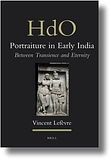Portraiture in Early India
Lefèvre, Vincent:
Portraiture in Early India : between Transience and Eternity / Vincent Lefèvre. - Leiden [u.a.] : Brill, 2011. - xix, 219 S. : Ill. - (Handbook of Oriental Studies, Section 2: South Asia ; 25)
ISBN 978-90-04-20735-6
EUR 99,00 / US$ 135,00
DDC: 704.94250954 (dc23); 704.9420934 (dc22)
-- Angekündigt für Juli 2011 --
Beschreibung
In the study of Indian art prior to the Mughal period, portraiture has so far been much neglected, when its existence has not simply been denied. This book is an attempt to reassess this issue, by showing that portraits have existed in great number in early India, since probably the first artistic achievements. Through a close scrutiny of sculpted and (more rarely) painted images brought together with textual and epigraphical references, it aims at highlighting the specificities of Indian portraiture, its relationship with divine images and, consequently, at understanding the development of Indian imagery. It questions also the social and religious implications related to this issue. [Verlagsinformation]
Inhalt
Foreword. xi
Acknowledgements. xiii
List of Figures. xv
Abbreviations. xxi
Introduction: Portraiture, a Problematic Issue. 1
I. IDENTIFYING PORTRAITS. 23
1. Painted portraits. 23
2. Portraits in the round and devotional portraiture. 31
2.1 Life-size and free standing portraits. 31
2.2 Devotional portraiture. 35
3. Coins. 39
4. Double-meaning images. 41
5. Naming the image. 46
II. VIDDHA / AVIDDHA. DIFFERENT KINDS OF PORTRAITS FOR DIFFERENT KINDS OF PURPOSE. 53
1. Some study cases. 53
1.1 Narasiṃha Gaṅga. 54
1.2 Kṛṣṇadevarāya. 55
1.3 Rājarāja I. 57
1.4 Jayavarman VII. 58
2. The likeness issue: textual evidence. 59
3. Physiognomic portraits. 65
3.1 Portraiture and identity. 65
3.2 Portrait as a substitute. 68
3.3 The Pratimānāṭaka or the ambiguity of likeness. 72
4. Typological portraits. 76
5. Portraiture as social and historical marker. 80
III. PORTRAITS, WORSHIP AND DIVINE IMAGES. 85
1. Portraits, commemoration and death. 85
2. Portraiture and funerary and/or dynastic temples. 90
2.1 The Pratimānāṭaka. 90
2.2 Kuṣāṇa dynastic shrines. 91
2.3 South Indian 'funerary' temples. 94
2.4 'Funerary' temples in Southeast Asia. 98
3. Divine portrait, human portrait. 102
3.1 Myths on the origin of images. 102
3.2 Divine images as portraits. 105
3.3 Ritual installation (pratiṣṭhā) of portraits. 109
4. Portraiture and deification. 112
IV. THE ORIGIN OF PORTRAITURE AND THE REPRESENTATION OF HEROES. 119
1. Portraiture in pre-and proto-historical times. 119
2. Portraiture in the Early-Historical period (Maurya-Śuṅga times). 123
2.1 Early human figures. 123
2.2 Portraits or Yakṣas? 124
3. Portraits and the first 'divine images' at the beginning of the era (Kuṣāṇa period). 136
3.1 Stories on the origin of the images of Buddha and Mahāvīra. 137
3.2 The Vṛṣṇi Vīras and the first representations of Kṛṣṇa. 144
V. THE ROYAL PORTRAIT, PORTRAIT PAR EXCELLENCE? 149
1. The king as model. 150
1.1 In normative treatises. 150
1.2 The king as visual source. 155
2. Portraiture as political instrument. 158
2.1 Diplomacy, propaganda and legitimization. 159
2.2 Historical reliefs. 161
3. Allegorical portraits. 164
3.1 Allegorical portraits under the Guptas. 164
3.2 Allegorical portraits under the Pallavas. 168
3.3 Portraiture and political metaphors. 180
Appendix: Vaikuṇṭhaperumāḷ Temple, Kanchipuram: Iconography of the Surrounding Galleries. 183
Concluding Remarks. 189
Bibliography. 195
Index. 217
Autor
VINCENT LEFÈVRE, Ph.D (2004) in Indian Studies, Université Sorbonne Nouvelle Paris 3, is curator, formerly at the Musée Guimet, Paris, and now for the Louvre Abu Dhabi project. He has published extensively on Indian art and on Sanskrit normative texts.
Quellen: Brill; Amazon; WorldCat; Library of Congress
Ähnlich
- Rethinking Visual Narratives from Asia
- Bonpo Thangkas from Rebkong
- Flavours of the Arts
- Pahari Paintings of an Ancient Romance
- Vishnu
- Le Don de Voir
- The bejewelled Buddha
- Heritage conservation and research in India
- The Intelligence of Tradition in Rajput Court Painting
- Sears: Worldly Gurus and Spiritual Kings

